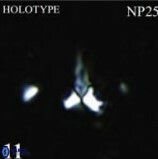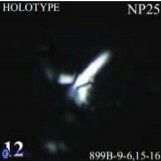Furcatolithus patifunditus
Sphenolithus patifunditus Bergen & de Kaenel in Bergen et al. 2017
Furcatolithus patifunditus has a duolithic biconical apical spine which is a kite shape in the axial section with an acute proximal angle and a proximal cycle in a hollow conical frustum shape [therefore, flares outwards].
Furcatolithus patifunditus differs from Furcatolithus ciperoensis (Bramlette & Wilcoxon, 1967) Howe, 2021 by having a hollow conical frustum shape proximal cycle flares outwards. In contrast, Furcatolithus ciperoensis has a relatively high cylindrical proximal cycle.
Furcatolithus patifunditus and Furcatolithus expansus Varol, in prep., have high hollow conical frustum shape proximal cycles (flaring outward). They differ by their proximal angle of the apical spines. Furcatolithus expansus has an obtuse proximal angle in the axial section, whereas Furcatolithus patifunditus has an acute proximal angle in their apical spines.
Bergen, J. A., de Kaenel, E., Blair, S. A., Boesiger, T. M. & Browning, E. 2017. Oligocene-Pliocene taxonomy and stratigraphy of the genus Sphenolithus in the circum North Atlantic Basin: Gulf of Mexico and ODP Leg 154. Journal of Nannoplankton Research 37(2-3): 77-112.
Bramlette, M. N. & Wilcoxon, J. A. 1967. Middle Tertiary calcareous nannoplankton of the Cipero section, Trinidad, W.I. Tulane Studies in Geology and Paleontology 5: 93-131.
Howe, R., 2021. Ultrastructure and taxonomy of the family Sphenolithaceae. Journal of Nannoplankton Research 39(1), 29-75.

